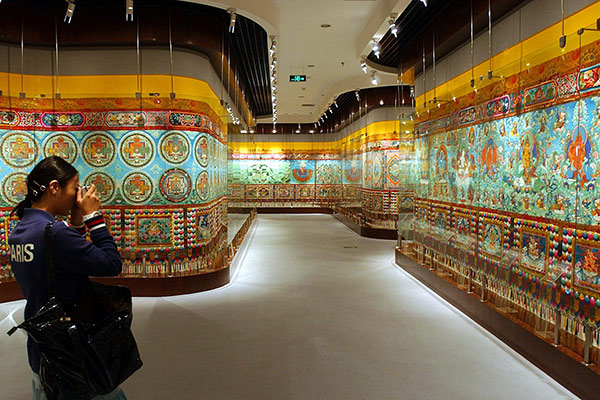
A visitor takes a picture of the 618-meter-long thangka scroll at the Tibetan Medicine Museum of China in Xining, capital of Qinghai province.[Photo/Xinhua]
We were amazed the planet’s longest thangka filled the room. Then we more amazed it also filled the next one. And the next one. And the next one. And so on. On and on. And on. We were literally lost in the Tibetan painting at the Tibetan Medicine Museum of China in Xining, capital of Qinghai province. The museum was closing. Lights were dimming.
And we couldn’t find our way out of the maze forged by the 618-meter-long scroll. It had to be mounted across numerous walls that jut in different directions to produce enough surface area to fit in the building’s second floor, carving several rooms out of a more than 70,000-square-meter area.
Without perpendicular wall intersections, the scroll simply wouldn’t fit in the museum’s entire second story.
Essentially, it’s like designing an entire floor around amazing wallpaper-rather than the other way around, as the world usually works.
But these walls create a labyrinthine experience that sends one’s inner compass spinning.
We started speedwalking to locate the exit before the last lights went off. Audio announcements of the closing became starker.
A security guard scouting for stragglers emerged to point us to the exit and then vanished. We entered the room he’d pointed toward to arrive in what turned out to be another sequence of chambers.
We were perhaps more lost than ever.
We thought the scroll was over. Must be.
Nope.
How? Wow!
Umm ... which way should we turn now?
It’d be roughly half a kilometer before we found the stairs. (And a restroom.)
The scroll is, indeed, epic in every sense.
It took over 400 ethnic Tibetan, Tu, Mongolian and Han scholars from the Tibet autonomous region, and Gansu, Qinghai, Sichuan and Yunnan provinces 27 years to put the final strokes on the horizontally protracted, 2.5-meter-high masterpiece.
The astonishing artwork renders a cosmovision that can perhaps be thought of a very different take than Stephen Hawking’s on a “brief history of time”, not only in content but also in presentation.
It’s a recitation of everything-abridged, despite its great length.
The picture story begins with the universe’s emergence. It soon after shows early hominids discovering tools, fire and hunting. It chronicles biological, technological and societal evolution to modern man, amid the context of the spiritual advancement of Buddhism, while triumphantly declaring Tibetan medicine to be 3,800 years old.
Our legacy literally unfolds across the scroll to show animals roving wild and then pacing in pens, while humans move from mud huts to brick buildings. The saga’s final punctuation point is the present period.
The floor’s only other display is The Great Book-a 1.5-ton copy of the 156-chapter medical code Tibetan intellectual Yuthok Yonten Gonpo compiled between 773 and 783.
The compendium’s most massive edition is 2.5 meters high and over 2 meters wide.
Silver, pearl and coral powders artistically present 2.5 million articles over 490 pages that took craftspeople and calligraphers more than four years to complete.
Its superlative character may be better recognized if it weren’t juxtaposed against The Great Scroll.
Ultimately, and seemingly unintentionally, the Tibetan Medicine Museum of China is an art museum as well as an institution elucidating traditional healing.
Yet it remains relatively unknown, despite containing the Guinness World Record-setting scroll. That is, the artwork we discovered you can lose yourself in-and your way out of.
The magnificent masterpiece isn’t the museum’s only painting.
The first floor is full of anatomy diagrams that signage claims have been used for two millennia.
That said, some depict anthropomorphic creatures with, for instance, goat heads and snake bodies being swallowed by fish. (Hopefully, they’re recognized as outdated.)
Diseases are depicted as sword-fights with snakes, stabbings by blades and stings by scorpions. (Figuratively, we trust.)
The diagrams about behavior, skeletal systems and poisoning also display instruments for bloodletting, surgery and autopsy. Implements’ replicas are exhibited alongside.
It’s a shame we had to dash to escape the scroll in particular and the museum in general.
It’s the kind of place where you could get lost for a day-ideally, on purpose.
